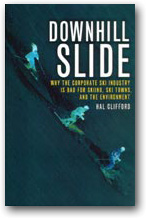 Any skier who has skied in America for the past 20 years can’t help but notice how the sport has changed. In Massachusetts, where I grew up, there are 120 “lost” ski areas: mom and pop establishments that are now defunct. Massachusetts skiers are instead traveling to larger, destination resorts both in New England and further afield. Increasingly, these resorts are owned and managed by the “big three” publicly traded ski companies: Intrawest, Vail Resorts, and the American Ski Company (ASC). These new venues are carefully engineered four season resorts, where skiing is just one of many “experiences” that a visitor may enjoy. In fact, the average destination skier now spends only 4 hours a day skiing. The remainder of his or her time is now devoted to enjoying other experiences, ranging from shopping to fine dining.
Any skier who has skied in America for the past 20 years can’t help but notice how the sport has changed. In Massachusetts, where I grew up, there are 120 “lost” ski areas: mom and pop establishments that are now defunct. Massachusetts skiers are instead traveling to larger, destination resorts both in New England and further afield. Increasingly, these resorts are owned and managed by the “big three” publicly traded ski companies: Intrawest, Vail Resorts, and the American Ski Company (ASC). These new venues are carefully engineered four season resorts, where skiing is just one of many “experiences” that a visitor may enjoy. In fact, the average destination skier now spends only 4 hours a day skiing. The remainder of his or her time is now devoted to enjoying other experiences, ranging from shopping to fine dining.
For author Hal Clifford, a lifelong skier and the former real estate editor at Ski Magazine, the big three are exacting a horrible toll on both natural environment of the mountains and the human communities that inhabit these “last great places.” According to Clifford, they “never relent in their quest for a fatter bottom line, and so they strive for growth and more growth in mountain environments that have reached or exceeded the limit of their ability to support both human activity and a diverse and robust ecosystem.”
While these corporations aim to grow through massive expansion projects, the actual base of skiers is stagnating and may soon decline as baby boomers leave the sport.
“Without snowboarding, which came of age in the late 1980s and in the winter of 1999 accounted for 26 percent of lift tickets sold,” contends the author, “the number of skier days might have declined by double digits since the late 1970s.”
To offset for these depressing numbers, ski companies have had to diversify away from lift ticket sales towards other “opportunities.” Real estate has evolved into that alternative. Clifford argues that ski areas have become “amenities to drive real estate sales.”
The “big three” sell both commercial and residential real estate. Commercial real estate is sold primarily in the “village” part of the resort. The big three take great pains to design villages that maximize a visitor’s “experience,” which according to the author is “a code word for an opportunity to get a visitor to spend money.”
Stores selling small indulgences such as food items and trinkets are placed on the “main streets,” and higher-end establishments are hidden on byways where they can be “discovered” by more serious shoppers. Companies like Intrawest not only choose who gets to sell what, and where, but also control everything from the interior design of the stores to their hours of operation. Store owners must sign carefully worded agreements with Intrawest before moving in and agree not only to pay rent and fees but also to adhere to corporate rules and regulations. In this way, Intrawest’s tenants “serve as human window dressing that disguises a corporate strategy committed to harvesting an ever larger share of visitor dollars.”
The base village at Whistler-Blackcomb. Photo courtesy Whistler-Blackcomb Resort and www.insight-photography.com.
The other means by which resorts reap profits through land is by selling large numbers of 600-850 square foot condominiums. Companies like Intrawest only want their buyers to be “moderately rich.” The true wealthy do not buy condominiums; they buy houses and often are not interested in putting their homes on the rental market. These empty houses are known in industry parlance as “cold beds.” What large resorts want is “hot beds” -; units rented out with a high occupancy rate that function more as hotel rooms than second homes. In this manner, the resort profits in three ways: from the sale of the unit, from its rental, and from income earned selling other resort services to renters.
For Hal Clifford, the problem with this development “arms race” is threefold. First, it is wreaking havoc on the environment. Real estate development pushes animals out of their natural habitats, and brings more pollution to the mountain environment in the form of cars and wood fires. Snowmaking further damages the eco-system by lowering stream levels and damaging the watershed. In the West, for example, less water in streams means a higher ratio of heavy metal to water.
The second problem is that big resorts are destroying many mountain communities. “Ski bums” can no longer afford to live in ski towns, and as result, these towns are losing their character and mystique. In times past, ski area workers used to be young people who traded in a middle class lifestyle to live and work in the mountains for a couple of years. These were people whom visitors envied for their freedom and counter-cultural lifestyle. Today, Clifford argues, ski area workers tend to be recent immigrants, often from Latin American countries. These workers have little interest in the sport, and work for low wages at ski areas simply to survive. Moreover, because these workers cannot afford to live near expensive ski resorts, they must commute many miles to earn their meager wages, and therefore contribute mightily to increased traffic and pollution in the mountains. These working poor also bring many “urban problems” to the mountains, and put tremendous strain on the social services of rural counties with meager tax bases.
The final problem with the big resorts is that their business model is not sustainable. What will happen to these resorts when the real estate runs out? How do you sustain growth in an industry where the numbers are stagnating?
This is perhaps the most vexing issue raised by the book. Clifford points to the recent implosion in the share price of the American Ski Company (ASC) as evidence that the ski industry may be in trouble. His prescription is for the industry at large to begin doing what ASC is in the process of doing: divesting. ASC recently sold Sugarbush in Vermont to a group of community investors after local citizens successfully blocked a recent bid for expansion. The new owners of Sugarbush will attempt to align the interests of the resort with those of the local community even if that means slower growth and smaller revenues.
Clifford, in short, believes that a new business model based on the concept of local ownership and slow or no growth may be the wave of the future. He admires smaller resorts such as Mad River Glen, Bogus Basin, and Bridger Bowl -; non-profits with low cost operations that serve the needs of a community and also attract a small numbers of tourists -; over large resorts that depend on increased development (bigger villages, faster lifts, more snowmaking) to win over a declining number of destination skiers from other behemoths.
Intrawest Corporation owns local favorite Snowshoe Mountain Resort. In recent years, Intrawest has developed a mountaintop village at the West Virginia resort. Photo provided by Snowshoe Mountain Resort.
So what does this all mean for the Mid-Atlantic? The Mid-Atlantic is a very different world than the ski regions Clifford’s book examines: the West and the Northeast. This is one of the few areas of the country where ski ticket sales are actually increasing, albeit modestly. Moreover, many of the environmental problems of the West do not exist here. Few endangered animals choose to make the Mid-Atlantic their home, and most of our resorts also possess more than adequate water resources for snowmaking. Most of our mountains are also relatively small places that cater mainly to day-trippers and weekend overnighters. In fact, only two areas here qualify as destination resorts -; Seven Springs and Snowshoe -; and only one, Snowshoe, is currently owned by a publicly traded company, Intrawest. So is Snowshoe as much of a problem as Clifford suggests?
My experience skiing and writing about Snowshoe suggests a different story. Snowshoe is not the problem: we are the problem. Intrawest works extremely hard to deliver exactly what skiers want: more terrain, more snowmaking, faster lifts, comfortable and affordable second homes, and more “experiences” we can enjoy while not skiing. This is what we want and Intrawest is delivering the goods -; perhaps better than any other company. It is no accident that Ski Magazine readers voted one of its resorts, Whistler-Blackomb, as the number one resort in the world. Whistler simply blows the competition away in almost every category just as Snowshoe does locally. No other resort in the Mid-Atlantic offers 1,500 feet of high-speed lift served vertical. No other resort in the region consistently offers first-class skiing from November through April. As Skip King, Chief Spokesman for ASC put it,
In the Mid-Atlantic, destination resorts like Snowshoe and Seven Springs (as well as several well-run commuter resorts) are literally knocking themselves out to make this experience more comfortable, especially for the increasingly ubiquitous non-skiers in the group. Is there a danger that they will expand too much and too fast? Sure, but these companies hardly want to kill the goose that lays the golden eggs. They are as interested in sustainable growth as we are; however, going “back to the future,” as Clifford recommends, is probably not the solution.
Do we really want to go back to the bad old days of slow lifts, no snowmaking, short seasons, shoddy lodges, small vertical, and limited grooming?
Hopefully, the past is not the prologue. Throughout his book, Clifford implies that there once was a “golden age” of skiing, where things were cheap and mom and pop resorts thrived. Having skied during those golden days, I can truthfully write that while I enjoy my nostalgic memories of the 174-foot vertical of the Bedford Massachusetts ski resort, I don’t have any desire to go back to that kind of skiing.
I want big vertical, lots of snow, fast lifts, and as many conveniences as a resort will provide. On the other hand, “community” resorts that offer fun skiing on the cheap are a great way to attract new skiers and boarders to the sport. What we really need is a high/low mix of resorts. We need destination resorts for experienced skiers willing to pay a premium for first-class services, but we also need cheap local mountains where kids can explore the sport for the first time. Hopefully, the Mid-Atlantic and the ski industry at large can achieve such a balance and continue to keep us sliding happily downhill.
Downhill Slide is available for purchase from Amazon.com.
John Sherwood is a columnist for DCSki. When he's not hiking, biking, or skiing, he works as an author of books on military history.

Join the conversation by logging in.
Don't have an account? Create one here.